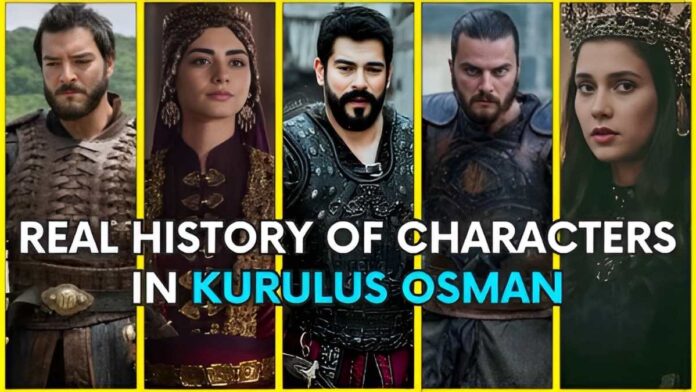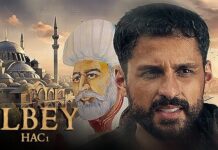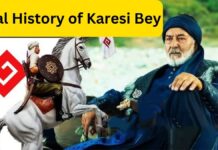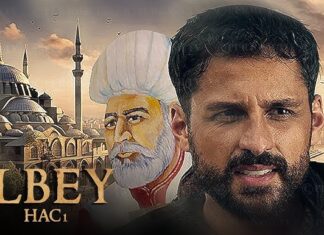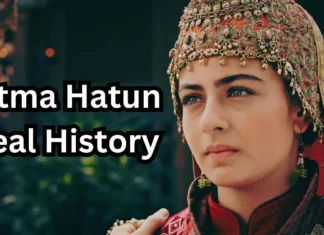Kurulus Osman is a Turkish historical drama television series that depicts the life and struggles of Osman I, the founder of the Ottoman Empire. This series is a sequel to the popular show Dirilis: Ertugrul, which focuses on the life of Osman’s father, Ertugrul Ghazi. In this post, we will discuss the real history of all characters in Kurulus Osman. Who played an important role alongside Osman Ghazi in the establishment of the Ottoman Empire, which lasted for over 600 years. Nowadays, Kurulus Osman Season 6 is premiering on atv. In this article, Real History of all Characters in Kurulus Osman from season 1 to season 6 are discussed below.
Karasi Bey Real History:
Karasi Bey was the leader of one of Anatolia’s most significant emirates, the Karasi Emirate. Situated along the coastal regions of northwestern Anatolia, this emirate, although influential, could not sustain itself for long, unlike the Germiyan and Kerman emirates. The Karasi Emirate existed for a short span, and its eventual annexation into the growing Ottoman Empire marked a pivotal moment in history.
Foundation of the Karasi Emirate
The origins of Karasi Bey’s rule trace back to 1243, when the Seljuk Sultanate was defeated by the Mongols in the Battle of Kösedağ. This defeat severely weakened Seljuk power, allowing local lords to rise and establish their own territories. In 1296, Seljuk border lord Kilim Shah and his son Kara İsa Bey captured several Byzantine cities and laid the foundation for the Karasi Emirate.
Expansion and Naval Strength
Karasi Bey’s conquests began in 1282, and by 1302, he had expanded his territory significantly. When Byzantine Emperor Andronikos II formed an alliance to curb Turkish influence in the region, Karasi Bey further advanced his conquests by attacking Byzantine territories. His forces managed to confront the Byzantines for years, eventually capturing all of Mysia, a crucial region in northwestern Anatolia.
The Karasi Emirate and the Ottoman Empire both emerged during the same period. In 1299, Osman Bey declared his independent emirate, and Karasi Bey was already consolidating his own power in nearby regions. However, the Karasi Emirate lasted only 42 years, while the Ottoman Empire endured for more than 650 years.
Annexation by the Ottomans
After Karasi Bey’s death, his son Demirhan succeeded him. However, Demirhan struggled to maintain the support of the local population. Seizing this opportunity, the Ottoman ruler Orhan Gazi launched an attack on the Karasi Emirate and annexed it into the Ottoman Empire without facing significant resistance.
Who Was Yakub I of Germiyan
In the gripping saga of Kuruluş Osman, one character stands out as a formidable adversary to Osman Bey – Yakub Bey, the leader of the powerful Germiyan tribe. Throughout history, Yakub Bey’s rivalry with Osman Bey became legendary, influencing the relations between their tribes for generations.
Yakub Bey was the head of the Germiyan tribe, a prominent group in Anatolia during the 13th century. If you’ve seen Season 1 of Kuruluş Osman, you’ll recall that the Germiyan tribe was introduced as a significant player in the region, often at odds with Osman Bey’s Kayı tribe. Alishar, a key figure from the Germiyan tribe, was shown to be one of Osman’s earliest enemies.
Historically, the Germiyan tribe was an offshoot of the Kıpçak-Kangly tribe, renowned for their bravery and resilience. In the 12th century, they migrated to Anatolia, seeking refuge from the Mongol invasions. Establishing themselves in the region of Kütahya, the Germiyan tribe grew in power and prestige, even fighting against both the Mongols and the weakened Seljuk Sultanate of Rum.
In 1283, the Germiyan tribe rebelled against the Seljuks, unhappy with the Mongol-controlled Sultan Masud II. The rebellion, lasting until 1299, resulted in Yakub Bey forming an alliance with the Ilkhanate Mongols in 1300. This move allowed the Germiyan tribe to declare their own sovereignty, establishing their rule in Western Anatolia.
In 1305, he captured Alaşehir, but the Byzantines later reclaimed it with the help of the Catalans. Yakub Bey and Osman Bey’s rivalry intensified over the control of the Jehsar Fortress, with Osman Bey eventually conquering it despite Yakub Bey’s larger and more powerful army.
Yakub Bey’s death in 1327 marked the end of an era, but the animosity between the Germiyan and Kayı tribes continued for generations. His son Mehmet Bey followed in his father’s footsteps, keeping the rivalry alive. Even in Kuruluş Osman Season 5, we witness Mehmet Bey as a worthy successor to his father’s legacy, continuing the longstanding conflict with Osman Bey’s descendants.
Orhan Ghazi: Successor of Osman bey
Orhan bey was the son of Osman bey and Malhun Hatun. He succeeded Osman Bey and became the 2nd ruler of new established Ottoman Empire. He was born in Sogut in 1381. He reigned from 1324 to 1362. One of the remarkable achievements of Orhan Bey was the Conquest of Bursa. According to the source, Orhan Bey was married to Nilufer Hatun who gave him the next successor of the Ottoman Empire, Sultan Murad I. In Kurulus Osman, a love story of Osman ghazi and Holofira is shown but Orhan bey is married to a different girl, Elcin Hatun. In season 6, he will meet again with Holofira and marry Holofira who will become Nilfuer Hatun later.
During his reign, Orhan Bey captured Bursa, which he had blockaded for years, and established the first mint in Bursa. The Byzantine Empire recognized the Ottomans’ expansion through the Black Sea and Istanbul, and Orhan Bey forced the Byzantine Emperor to flee. After making peace with the Byzantines, Orhan Bey took over the Karesids (Karesi Beylik) in Anatolia and expanded the borders until Çandarlı in the south. He married four different women, including Nilüfer Hâtun, Asporça Hâtun, Theodora Hâtun, and Eftandise Hâtun.
Holofira: Nilufer Hatun (Wife of Orhan Ghazi)
Nilüfer Hatun is known as the first wife of Orhan Ghazi and the mother of Sultan Murad I. Originally named Holofira, she converted to Islam and was given the name Nilüfer. She became the first Byzantine woman to join the Ottoman royal family. Tragically, Holofira lost her mother at a very young age. At just 11 years old, her father wanted to marry her off to the governor of Belica for political gain. But fate had other plans.
The Love Story of Holofira and Orhan Ghazi
Holofira first met Orhan Bey when she tried to escape the marriage out of fear. While fleeing, she encountered Orhan during one of his hunting expeditions, and he took her to the Kayi tribe. However, Holofira was later sent back to her family. It was during this time that Orhan and Holofira fell deeply in love. For a while, they were separated, unable to see each other. Eventually, when her marriage to the governor of Belica was finalized, Osman Bey and Orhan abducted her, bringing her to Yenişehir.
Holofira and Orhan’s love story reached its pinnacle when Osman Bey arranged their marriage. However, some historians have debated whether Holofira was truly kidnapped or not. Despite facing many challenges, Holofira became the wife of a Sultan and the mother of future leaders. Their children included Suleyman Pasha, Kasim Bey, and Sultan Murad I, who went on to become one of the most celebrated Sultans of the Ottoman Empire.
In 1362, when Orhan Bey passed away, Nilüfer Hatun held the title of Valide Sultan (Queen Mother), as her son Murad I ascended to the throne. She passed away one year after Orhan Bey, at the age of 100, and was buried next to him in Bursa.
To honor his mother’s memory, Sultan Murad I built a museum in her name, which still stands today, serving as a tribute to Nilüfer Hatun’s remarkable life and legacy.
Osman I: Founder of Ottoman Empire:
Osman I, also known as Osman Ghazi, was the youngest son of Ertugrul Ghazi. Osman Bey officially founded the Ottoman Empire in 1299. He died in 1326, 2 years after the death of Bala hatun.
Bala Hatun: Love of Osman Ghazi
Bala Hatun was the beloved wife of Osman Bey, the founder of the Ottoman Empire. She was the daughter of Sheikh Edebali, a respected Islamic scholar and spiritual leader who played a significant role in the early development of the Ottoman state. She had only one son, Allaeddin Pasha. She died in 1324 CE at the age of 66 years.
Sheikh Edebali: Sipiritual Mentor of Osman Ghazi
Sheikh Edebali, born in 1206 in Inak, Turkey, was a respected Turkish Sufi Sheikh and spiritual mentor to Osman Ghazi. He played a crucial role in shaping the Ottoman Empire’s early policies. As a descendant of the Banu Tamim tribe, he was highly regarded in the Muslim world and advised Osman with wisdom that emphasized patience, justice, and unity. He died at the age of 120 in 1326 CE and was buried in Belisik, Turkey, leaving a lasting legacy through his teachings and family connections. His daughter, Bala Hatun married Osman ghazi.
Who was Yunus Emre in Kurulus Osman
Yunus Emre was born around 1238 in Sivrihisar, Türkiye. Yunus Emre, a 13th-century Turkish Sufi poet, greatly influenced Anatolian culture by writing in vernacular Turkish, unlike his contemporary Rumi who wrote in Persian. His poetry, known for its personal mysticism and humanism, resonates with people across regions from Azerbaijan to the Balkans. Emre’s simple, direct approach and use of the common language made him a beloved figure in Turkish literature, with multiple localities claiming his heritage. He died around 1320, making him approximately 82 years old at the time of his passing.
Malhun Hatun: Second Wife of Osman Ghazi
In History, Malhun Hatun was the first wife of Osman Ghazi but in the Kurulus Osman Series, she made her entry as the second wife of Osman Bey. She was the daughter of Omer Bey. Malhaun Hatun is the mother of 2nd Sultan of the Ottoman Empire, Orhan Ghazi. So She is considered as first Walida Sultan (Mother of Sultan). She is also mother of Fatma Hatun. She was born somewhere in Anatolia in 1260 AD and died in Sogut in 1326 AD.
Omer Bey: Father of Malhun Hatun
Omer Bey was the father of Malhun Hatun, Bey of the Bayındır tribe. Bayindir tribe is a Oghuz tribe settled in Anatolia. He was the son of Kızıl Bey. A war veteran formerly loyal to the Seljuks, famed for battles against the Mongols. He was the most renowned bey in Anatolia. He was martyred by Barkin Bey for supporting Osman Bey.
Fatma Haun (Daughter of Osman I)
Fatma Hatun, also known as Fatima Sultan or Fatima Malka Hatun, was the only daughter of Osman Ghazi, the founder of the Ottoman Empire. She is not widely known in history, but her importance as the first princess of the Ottoman dynasty cannot be denied.
Osman Ghazi had six sons and one daughter, Fatma Hatun. While his sons, especially Orhan and Alauddin, are well remembered in history, Fatma Hatun’s life also holds significance. Born in 1284 in Sögüt, Fatma grew up in a time of great change, as the Ottoman Empire was beginning to take shape.
Fatma Hatun, like her brothers, was skilled in swordsmanship and archery, a reflection of her noble lineage from her mother, Halime Hatun. Despite being the only daughter, she was deeply loved and cherished by her father, Osman Ghazi, who would always meet her first upon returning from battles.
Andronikos II Palaiologos: Constantine Emporer
Andronikos II Palaiologos was the Byzantine emperor from 1282 to 1328, known for his attempts to economize by reducing military forces, which ultimately weakened the empire. His reign experienced a significant civil war against his grandson, Andronikos III, leading to his deposition in 1328. Michael VIII Palaiologos and Theodora Palaiologina’s eldest surviving son, Andronikos, was acclaimed co-emperor in 1261 after his father reclaimed Constantinople from the Latin Empire, but he was not crowned until 8 November 1272.
Alisar Bey: Emir of Seljuk Sultanate of Rum
In real-life history there were two personalities having the name of Alisar Bey. Both of them belonged to the Germiyan dynasty and were father and son. During Seljuk period, both of them were the Emirs and Sanjak Beys having a lot of Beyliks and principalities under their control as vassal states. Ertugrul’s and Osman’s Beylik was also one of all these principalities and Beyliks which means Alisar Bey was the overlord to these also.
Alisar Bey challenged the authority of Mesud II of the Seljuk Empire of Rum and formed an alliance with the Ilkhanids to establish his own state. He raided the local Byzantine Empire and compelled them to pay tribute to him for some time. Alisar Bey also conquered Angir and Ayaslug, now known as Simav and Selcuk respectively. It has also been reported that Alisar Bey was on friendly terms with Dundar Bey of the Kayi Tribe. During the establishment of the Ottoman Empire, Alisar Bey’s relations with Osman Ghazi were strained which led to the lasting hostility between the Germiyans and the Ottomans.
It has also been reported that Alisar Bey was on friendly terms with Dundar Bey of the Kayi Tribe. During the establishment of the Ottoman Empire, Alisar Bey’s relations with Osman Ghazi were strained which led to the lasting hostility between the Germiyans and the Ottomans.
Gunduz Bey: Brother of Osman Ghazi
Gunduz Bey was the elder brother of Osman Ghazi, the founder of the Ottoman Empire. He played a crucial role in the empire’s early formation. Gunduz Bey was born in 1245 in Sogut, Kayı Tribe (now Sogut, Turkey). Gunduz Bey was instrumental in supporting Osman Ghazi during crucial battles and territorial expansions, contributing significantly to the early successes of the Ottoman state.
Gunduz Bey’s son Aydodu Bey fought alongside Osman Ghazi, illustrating the familial bonds that strengthened the early Ottoman efforts. He died in 1299 in Inegöl, Ottoman State (now Inegöl, Turkey)
Savci Bey: Brother of Osman Ghazi
Savci Bey, the middle son of Ertuğrul Gazi, was highly revered and beloved. He was martyred in 1281 CE during the battle at Ekizce (Domaniç Pass) while defending against Kalanoz’s attacks. Many poems have been written in tribute to his martyrdom.
The commemoration of the martyrdom of Savcı Bey is held every year on the last weekend in August at his memorial in Karaköy. According to records, he was married to Ana Sultan (Kutlu Melek) and they had 2 sons: Süleyman Bey and Bayhoca (who was martyred in an ambush), and 1 granddaughter, Hatice, through their son Süleyman Bey.
Thanks for Reading, We will Adding more and more characters brief history in this article, comment now for more historical characters, thanks

